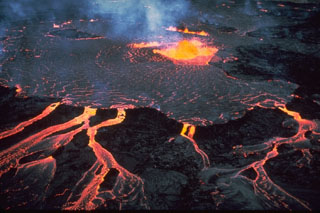Report on Kilauea (United States) — 7 May-13 May 2025
Smithsonian Institution / US Geological Survey
Weekly Volcanic Activity Report, 7 May-13 May 2025
Managing Editor: Sally Sennert.
Please cite this report as:
Global Volcanism Program, 2025. Report on Kilauea (United States) (Sennert, S, ed.). Weekly Volcanic Activity Report, 7 May-13 May 2025. Smithsonian Institution and US Geological Survey.
Kilauea
United States
19.421°N, 155.287°W; summit elev. 1222 m
All times are local (unless otherwise noted)
The Hawaiian Volcano Observatory (HVO) reported that the eruption within Kilauea’s Kaluapele summit caldera, from two vents along the SW margin of Halema’uma’u Crater, continued at variable levels during 7-13 May. Visible incandescence from the 6 May lava flows on the crater floor decreased during 7-9 May. Incandescence at both the N and S vents was visible during 7-11 May. Occasional spattering at the N vent occurred during 0400-0530 on 9 May.
Intermittent spatter, hydrogen flames, and low-level lava fountains were observed at the N vent overnight during 10-11 May. Lava fountaining was observed specifically at 0420, 0530, 0800, 0830, and 0910 on 11 May, and followed by additional numerous small fountains. The last three specified events were characterized by cycles of dome fountaining, lava ponding, and lava drainbacks. Sustained lava fountains that began at 1245 quickly grew in vigor and height, rising over 150 m within an hour. Intense sulfur dioxide emissions (estimated to be around 50,000 tonnes per day) accompanied the ejection of tephra and the formation of Pele’s Hair. Lava flows advanced more than 1 km along the N edge of the crater floor. The fountain heights cycled from 60 m to more than 150 m at about 10-minute intervals during 1400-1600, recorded as oscillations in tremor data. After 1600 the height was more consistent, averaging 120 m until the activity ceased at 2034. Overall, fountaining was sustained for seven hours and 51 minutes. Minor fountaining to 15 m began at the S vent just before the activity at the N vent ceased, and then stopped at 2036. Lava covered about 50 percent of the crater floor. Incandescence at both the N and S vents was visible overnight during 11-12 May. The Volcano Alert Level remained at Watch (the third level on a four-level scale) and the Aviation Color Code remained at Orange (the third color on a four-color scale).
Geological Summary. Kilauea overlaps the E flank of the massive Mauna Loa shield volcano in the island of Hawaii. Eruptions are prominent in Polynesian legends; written documentation since 1820 records frequent summit and flank lava flow eruptions interspersed with periods of long-term lava lake activity at Halemaumau crater in the summit caldera until 1924. The 3 x 5 km caldera was formed in several stages about 1,500 years ago and during the 18th century; eruptions have also originated from the lengthy East and Southwest rift zones, which extend to the ocean in both directions. About 90% of the surface of the basaltic shield volcano is formed of lava flows less than about 1,100 years old; 70% of the surface is younger than 600 years. The long-term eruption from the East rift zone between 1983 and 2018 produced lava flows covering more than 100 km2, destroyed hundreds of houses, and added new coastline.
Source: US Geological Survey Hawaiian Volcano Observatory (HVO)

